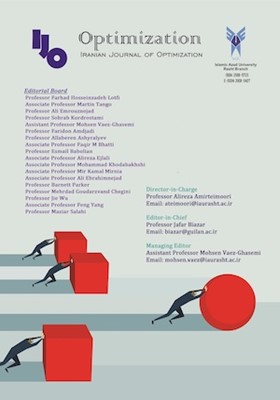Efficiency Evaluation in Presence of Undesirable and Negative Factors
محورهای موضوعی : Operation ResearchMahnaz Maghbouli 1 , Mahdi Eini 2 , Farhad Taher 3
1 - Department of Mathematics, Islamic Azad University, Aras Branch, Hadishahr, Iran
2 - Department of Mathematics, Payam-e-Noor University, Tehran, Iran
3 - Department of Applied Mathematics, Islamic Azad University, Tabriz Branch, Tabriz, Iran
کلید واژه: Negative data, Efficiency, Undesirable outputs, Data Envelopment Analysis(DEA),
چکیده مقاله :
Data envelopment analysis (DEA) has been proven as an excellent data-oriented efficiency analysis method for comparing decision making units (DMUs) with multiple inputs and multiple outputs. In conventional DEA models, it is assumed that the input or output variables are all non-negative and desirable. However, in some situations, a performance measure can take positive quantity for some DMUs and negative value for others. Also, undesirable (bad) inputs and outputs may be presented in the production process. Hence, the standard model cannot directly reflect the efficiency score. The paper proposes a modified model in which both undesirable and negative data are treated to improve the relative efficiency of the DMU under evaluation. The focus of this paper is on treating the negative data on the definition of the two non-negative variable and the decreasing of undesirable outputs. A real example of 20 bank branches shows applicability of the proposed approach
Data envelopment analysis (DEA) has been proven as an excellent data-oriented efficiency analysis method for comparing decision making units (DMUs) with multiple inputs and multiple outputs. In conventional DEA models, it is assumed that the input or output variables are all non-negative and desirable. However, in some situations, a performance measure can take positive quantity for some DMUs and negative value for others. Also, undesirable (bad) inputs and outputs may be presented in the production process. Hence, the standard model cannot directly reflect the efficiency score. The paper proposes a modified model in which both undesirable and negative data are treated to improve the relative efficiency of the DMU under evaluation. The focus of this paper is on treating the negative data on the definition of the two non-negative variable and the decreasing of undesirable outputs. A real example of 20 bank branches shows applicability of the proposed approach
Allen, K (1999). DEA in the ecological context-an overview, in: G.Wesermann(Ed.). Data Envelopment Analysis in Service Sector, Gabler, Wiesbaden,203-235.
Amirteimoori, Alireza, Kordrostami, Sohrab (2013). An alternative clustering approach: a DEA-based Procedure. Optimization, Vol 62, No 2, 227-240.
Asmild, Mette, Pastor, Jesus T (2010). Slack free MEA and RDM with Comprehensive Efficiency Measures. Omega, Vol38, No 6, 475-483.
Banker, Rajiv D, Charnes, Abraham, Cooper, William W (1984). Some Models for Estimating Technical and Scale Inefficiencies in Data Envelopment Analysis, Management Science, Vol 30, No 9,1078-1092.
Charnes, Abraham, Cooper, William W, Rhodes, Edwardo (1978). Measuring the efficiency of decision making units. European Journal of Operational Research, Vol 2, No 6, 429-444.
Chung, Y. H, Färe, Rolf, Grosskopf, Shawna (1997). Productivity and undesirable outputs: A Directional Distance Function Approach. Journal of Environmental Management, Vol51, No3, 229-240.
Eini, Mahdi, Tohidi, Ghasem, Mehrabian, Saeid (2017). Applying inverse DEA and cone constraints to sensitivity analysis of DMUs with undesirable inputs and outputs. Journal of the Operational Research Society, Vol68, No1,34-40.
Emrouznejad, Ali, Anouz, Abdel Latif., Thanassoulis, Emmanuel (2010). A Semi-Oriented radial measure for measuring the efficiency of decision making units with negative data, using DEA. European Journal of Operation Research, Vol 200, No 1, 297-304.
Esmaeilzadeh, A, Hadi-Vencheh, A (2015) A New Method for Complete Ranking of DMUs. Optimization, Vol 64. No 5, 1177-1193.
Färe, Rolf., Grosskopf, Shawna., Lovell, C.A.K, Pasurka, Carl (1989). Multilateral productivity comparisons when some outputs are undesirable: a nonparametric approach. The review of Economics and Statistics, Vol 71, No1, 90-98.
Jahanshahloo, Golam Reza, Hosseinzadeh Lotfi, Farhad, Shoja, Naghi, Tohidi, Ghasem, Razavyan, Shabnam (2005). Undesirable inputs and outputs in DEA models. Applied Mathematics and Computation, Vol. 169, No 2, 917-925.
Kazemi Matin, Reza, Salehi, Leila (1392). A Modified Bounded Model(BAM) associated with negative data. Journal of Applied Mathematics, Islamic Azad University of Lahijan, Vol 10, No.4,127-137 (In Persian).
Koopmans, T.C (1951). An analysis of production as an efficient combination of activities. Activity analysis of production and allocation. Monograph No. 13. John Wiley and Sons, Inc., New York.
Mehrabian, Saeid, Eini, Mahdi, Karimi, Balal (1391). Changing the level of inputs and estimating outputs in DEA in presence of undesirable outputs, Journal of Applied Mathematics, Islamic Azad University of Lahijan, Vol 9, No 2 ,121-130 (In Persian).
Pathomsiri, Somachai, Haghani, Amin, Dresner, Martin, Windle, Robert J (2008). Impact of undesirable outputs on the productivity of US airports. Transportation Research Part E: Logistics and Transportation Review, Vol 44, No 2, 235-259.
Portela, Maria C Silva, Thanassoulis, Emmanuel, Simpson, G (2004). Negative data in DEA: A directional distance approach applied to bank branches. Journal of the Operational Research Society, Vol 55, No 10, 1111-1121.
Seiford, Lawrence M, Zhu, Joe (2002). Modeling undesirable factors in efficiency evaluation. European Journal of Operational Research, Vol 142, No1, 16-20.
Sharp, J. A, Meng, Wang, Liu, Wei (2007). A modified slacks-based measure model for data envelopment analysis with ‘natural ‘negative outputs and inputs. Journal of the Operational Research Society, Vol 58, No 12, 1672-1677
Tao, Xueping, Wang, Ping, Zhu, Bangzhu (2016). Provincial green economic efficiency of China: A non-separable input–output SBM approach. Applied Energy, Vol 171, No 1,58-66.
Thanassoulis, Emmanuel, Portela, Maria C Silva, Despic, Ozren (2008). DEA-The Mathematical
Programming Approach to Efficiency Analysis. The Measurement of Productive Efficiency and
Productivity Growth, Oxford University Press, New York.
Tohidi, Ghasem, Matroud, Fatemeh (2017). A new non-oriented model for classifying flexible measure in DEA. Journal of the Operation Research Society, Vol 68, No 9,1019-1029.


